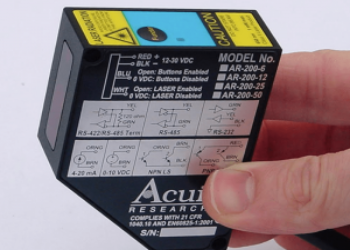- Have any questions?
- +61 424 178 561
- +61 3 9837 5203
- [email protected]
Triangulation Laser Displacement Sensors

When choosing a laser displacement sensor, it is important to have the knowledge of what needs to be measured, the accuracy required and the speed required for the laser displacement sensor. Slentech provides Laser Triangulation Sensors (Short Range Lasers) from Acuity with a measuring range from 3-1300 mm in Australia, New Zealand and Oceania.
AR200 LASER DISPLACENT SENSOR
The AR200 group of Laser Measurement Sensors from Acuity is the most compact series of Triangulation Laser Displacement Sensors. These Laser measuring devices aim a Class 2 visible laser spot onto your target to accurately gauge its distance. Designed to withstand difficult industrial environments, the AR200 Laser Triangulation Sensors are commonly used in forest products, medical and high tech industries. All models boast a 0.03% resolution across their entire measurement span. Acuity AR200 Laser Displacement Sensors are extremely useful to measure the displacement, distance and thickness for industrial use.
Dimensioning Solution; It is a complicated process to create vision-guided robotics, imaging systems, and dimensioning systems. A lot can go wrong. For a company like Artemis Vision, a machine-vision solution provider out of Denver, Colorado, it is vital to make every design decision count. All the parts in their machine systems must work together to ensure stability and repeatability. So, we are proud to say that, when it came time to develop their latest dimensioning solution, they chose AR200 Lasers from Acuity.
Flux Depth Measurement in Brazing Rods; Flux is a chemical cleaning agent that permits the flow of brazing or soldering metal on a base surface at high temperatures.
Displacement in Diesel Engines; Large diesel-powered generators combine inductors with diesel engines to produce thousands of kilowatts of power. These enormous pieces of capital equipment see extensive preventative maintenance and testing to reliably and efficiently operate in the field. The USA’s leading electric motor company uses four laser measurement sensors to measure the amplitude of vibration of large diesel generators. Their test setup uses sensors measuring displacement of the diesel engine (generator) support rails while the system is idling during heavy loading.
Measuring Speaker Cone Deflection Using Triangulation Lasers; A major car audio speaker manufacturer’s Research and Development Department chose AR200 laser measurement sensor to measure the positional changes of subwoofer cone.
AR500 LASER POSITION SENSOR
Acuity AR500 Laser Position Sensors use Triangulation measurement principles to gauge distances to targets with great accuracy and speed. Fitting in the palm of your hand, the unit’s size is ideal for builders of compact machines and systems. Laser Position Sensor models range from 5 to 1000 mm of measurement range at the speed of 9400 Hz. The AR500 Laser Position Sensors are the only Acuity models available with optional blue laser diodes.
Crash Test Laser Sensors; Automobile crash tests engineers use variety of Slentech sensors to record vehicle information during the last, split-seconds of the controlled impact. Acuity AR500 Laser Position Sensors are used to collect data of vehicle deformation, acceleration, temperature, etc. at high speed. This information is then analysed to determine avenues for improvement in safety.
AR700 LASER DISPLACEMENT SENSOR
The Acuity AR700 Laser Displacement Sensor is high-resolution laser distance measurement sensor. Models vary in measuring range and can achieve resolutions better than 0.2 micron. Increased sampling speeds to 9.4 KHz satisfy the requirements of the Road Profiling Industry. Acuity AR700 series of Laser Displacement Sensor measures position and object dimensions. The compact size AR700 boasts output speeds to 9400 Hz and resolutions as low as 0.005% (of the measurement span).
Wooden Door On-Line Thickness Measurement; One of Acuity’s customers manufactures wooden door at a rate of over 4,000 doors a day. The quality, fit and finish of the door must be as perfect as possible. At such a fast production environment they use AR700 Laser Displacement Sensor for accurate and precised thickness measurement.
Pavement Measurements with Laser Sensors; Profilometers using AR700 Laser Displacement Sensors provide high-quality measurements of pavement deformations at highway speeds. The equipment measures the longitudinal and transverse road profiles, International Roughness Index (IRI), wheel path rut depth, Ride Number (RN) and macro texture of asphalt and concrete surfaces.
Rubber Thickness Measurement; Most natural rubber products are made by calendering process where soft rubber material is fed between two hard cylindrical rollers to create a sheet. This sheet is then further pressed between hard rollers to create smoother and thinner rubber sheets. Many of rubber products manufacturers are using AR700 Sensors to monitor thickness of the sheet during the production process. The sheets can then be used for various products, including conveyor belts, tires or mats.
Mold Position Measurement; Manufacturer of pipe fittings and couplings cast these parts in sand molds. The automated process uses several pneumatic cylinders to put the molds into a properly “stacked” position. It is imperative that these molds are properly positioned so the front and back sides are aligned with the AR700 Laser Sensors.
Inline Board Thickness Measurement; Non-Contact Laser Displacement Sensors are used to measure the thickness of polystyrene foam-extruded insulation boards in a continuous manufacturing environment. The boards are composed of foam sandwiched between plastic film. The rigid boards are continuously produced and cut to length at subsequent stages in the process.
Height Measurement of Concrete Bricks & Blocks; The Block Qualifier is a height measurement device, used in the concrete brick and block industry. The Block Qualifier, uses Non-Contact Laser Measuring Sensor technology to gauge the size of concrete bricks.
Propeller Blade Profiling using Laser Sensors; Triangulation Laser Sensors can be used to measure the profile of its propellers and controllable tip blades during the manufacturing process. Non-Contact measuring, like that afforded by Laser Sensors, is desirable in propeller manufacturing because the fixed measuring device can be installed with a large standoff away from bulky and/or moving parts.
Laser Distance Sensors can measure Compression of Bamboo with high precision Non-Contact measurement sensor technology.
